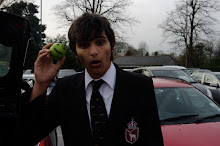Two children awake in their council flat on an unforgiving estate. With their mother asleep in bed with a stranger, they embark on a morning full of freedom. The only rules are the limits of their imagination. The stranger and the girl share an intense look. When he leaves, the boy hurtles into his mother’s bedroom. He hugs her tightly. Underneath her bed lies an abandoned syringe, empty of its deadly content. Framed by the window, the girl watches as the man walks quickly across the estate.
This short is very similar to a feature length film in style, in is fairly conventional and does not try to be experimental in any way and could easily be compared with something like Shane Meadows ‘This is England’ in style in the way it comments on social class and the representation of working class Britain. It has one many awards including the Brisbane film festival award, the Cardiff screen festival award, the Edinburgh film festival award and the D.M. Davies Bafta award, Cymru.
It was produced by fiction factory, funded by the Arts council of Wales and exhibited mainly through independent film festivals. It was also chosen by the BBC Network which specialises in showcasing new talented British filmmakers through their website, where I coincidentally found the film.
To watch the film, please click here
The film starts off relatively slowly showing a milk cart doing its rounds as well as showing establishing shots of a local council estate. These establishing are generally held for a relatively long time further enforcing the setting of the story which is crucial. Due to time constraints it is very important in this short that the audience are aware of the setting, a council estate, so the emphasis on it during the beginning is a good way of cementing it into the audiences‘ mind. It is also where we see a shot of some graffiti on a wall saying “ Charles and Diana, 29 July 1981’, a device for telling us when the story is set.
Generally the piece has very well composed shots, more care has been taken from an artistic point of view to make the piece aesthetically pleasing as it does not need to be so focused on driving the narrative. The use particular shots however are used to emphasise some of the underlying messages in the piece. For example the use of a birds eye view shot to show the boy pouring milk into the goldfish bowl emphasises the lack of parental supervision these children have from their mother as they are allowed to do what they want, their naive recklessness due to a lack of guidance can be seen at another point, when we see the door to the hamster cage is wide open. Subsequently many shots from floor level show the hamster running around the flat freely further connoting this lack of parental supervision.
The editing of the piece is fairly conventional without use of flashy editing techniques, it adheres to the rules of continuity editing occasionally harnessing temporal ellipses in order to pace up the narrative.
The use of ambient sound in the opening of the film gives more prominence to the gritty urban setting. A non-diegetic score runs throughout the piece, it is generally uplifting and happy but very relaxed and calming.
There are several recurring themes throughout the piece, one notably being the milk brought into the estate at the beginning. Milk is seen as something pure and innocent and is generally associated with children, yet in ‘Dawn’ the milk is stolen 4 times. The first time, by a postman walking past, the second by two teenagers who are caught by the milk man which causes them to drop the milk and smash the bottles. Once by a drunken man on the housing estate who drinks some then spills it all over the floor, and once by the little girl.
The train is another important recurring theme. The train line is featured 6 times in the piece, with the distinctive noise of the tracks and the trains themselves. This gives more prominence to the setting; the dirty grubby council estate. The area these children live in is portrayed as a bad place, the train line is cut to several times during the film to reinforce that they are not living in a nice or glamourous area.
In my opinion the main underlying point to this story is how these two innocent children are caught up in a bad world, a bad world that they most likely with eventually become a part of. It is a snapshot moral and social disintegration and these children are a product of the ongoing breakdown of society.




No comments:
Post a Comment